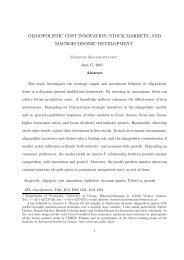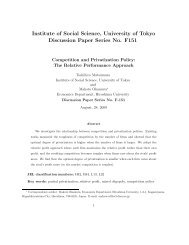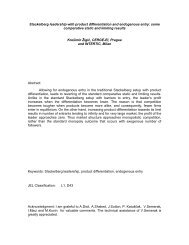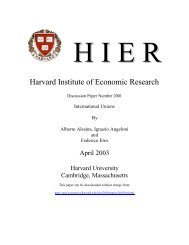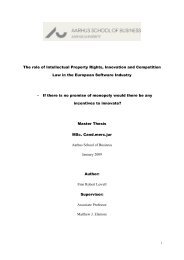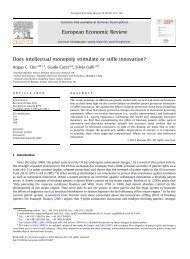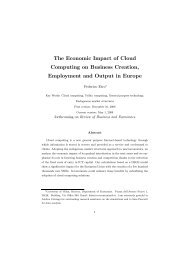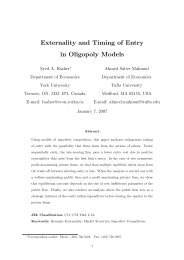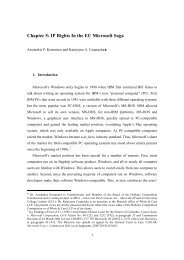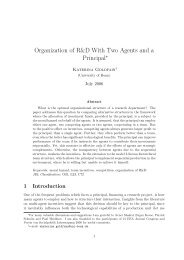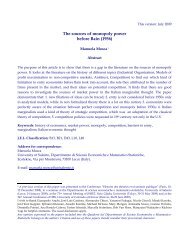The EU Approach to Abuse of Dominance - Intertic
The EU Approach to Abuse of Dominance - Intertic
The EU Approach to Abuse of Dominance - Intertic
Create successful ePaper yourself
Turn your PDF publications into a flip-book with our unique Google optimized e-Paper software.
measure. This is in line with the standard antitrust doctrine since Areeda and Turner (1974) 14 noticed<br />
that “the incremental cost <strong>of</strong> making and selling the last unit cannot readily be inferred from<br />
conventional business accounts, which typically go no further than showing observed average variable<br />
cost. Consequently it may well be necessary <strong>to</strong> use the latter as an indica<strong>to</strong>r <strong>of</strong> marginal cost”. However,<br />
the Discussion Paper substitutes the Areeda-Turner test based on AVC with the AAC, a sort <strong>of</strong> average<br />
marginal (or incremental) cost <strong>of</strong> the extra output <strong>to</strong> serve the preda<strong>to</strong>ry sales. Unfortunately, the AAC<br />
can be quite higher than the right theoretical concept whenever it accounts for fixed costs. Moreover the<br />
AAC can be much more difficult <strong>to</strong> measure than the AVC since it is almost always impossible <strong>to</strong><br />
precisely define which costs are sustained for a given output and isolate the extra output (supposedly the<br />
preda<strong>to</strong>ry output) from <strong>to</strong>tal output. Finally, there are well known conditions, as in presence <strong>of</strong> network<br />
externalities, under which pricing below marginal cost is a normal competitive strategy for a market<br />
leader. Hence it would be better <strong>to</strong> substitute the concept <strong>of</strong> AAC with that <strong>of</strong> average variable cost<br />
(AVC), in line with the traditional economic interpretations <strong>of</strong> the Areeda-Turner test.<br />
According <strong>to</strong> the Discussion Paper, where pricing is above AAC, but below average <strong>to</strong>tal cost<br />
(“ATC”), the Commission will need <strong>to</strong> show, on the basis <strong>of</strong> objective fac<strong>to</strong>rs, that the dominant<br />
company’s pricing has a “preda<strong>to</strong>ry intent” (i.e. predation cannot be presumed). ATC is the average <strong>of</strong><br />
the variable and fixed costs incurred by a company. Pricing above ATC is in general not considered<br />
preda<strong>to</strong>ry, but according <strong>to</strong> the virtually unanimous economic literature, it would be better <strong>to</strong> state that<br />
pricing above ATC is never preda<strong>to</strong>ry since it cannot lead <strong>to</strong> foreclosure <strong>of</strong> ‘as efficient’ competi<strong>to</strong>rs.<br />
In certain sec<strong>to</strong>rs, the Commission uses a long-run average incremental cost benchmark<br />
(“LAIC”), instead <strong>of</strong> AAC. This is usually the case in industries where fixed costs are high and variable<br />
costs very low. In these cases, the LAIC benchmark is used as the benchmark below which predation is<br />
presumed. Pricing above LAIC but below ATC in these sec<strong>to</strong>rs is assessed in the same way as pricing<br />
above AAC but below ATC in all other sec<strong>to</strong>rs (i.e. the Commission will need <strong>to</strong> prove a “preda<strong>to</strong>ry<br />
intent”). We believe that the long-run incremental costs standard is inconsistent with business reality<br />
because it requires companies <strong>to</strong> price <strong>to</strong> cover average long-run variable costs, which includes sunk<br />
fixed costs that are unrecoverable. This approach ignores the economic reality that, when businesses<br />
decide how <strong>to</strong> price a product, they do not consider costs that are “sunk” or “unrecoverable,” even if<br />
not a single product is sold. Indeed, if they were <strong>to</strong> consider such sunk costs in their pricing decisions<br />
they would engage in the so-called “sunk cost fallacy”, which is when a business person makes<br />
decisions based on the fallacy that money already irreversibly spent on a project might be “unspent” or<br />
recovered if the project is abandoned. <strong>The</strong> Discussion Paper’s reliance on long-run incremental costs <strong>to</strong><br />
measure foreclosure is based on the assumptions that an au<strong>to</strong>mobile fac<strong>to</strong>ry can be converted in<strong>to</strong> a<br />
14 See Phillip Areeda and Donald Turner (1975, “Preda<strong>to</strong>ry Pricing and Related Practices under Section 2 <strong>of</strong> the<br />
Sherman Act”, Harvard Law Review, 88, pp. 637-733) and, for an economic commentary, William Baumol (1996,<br />
“Predation and the Logic <strong>of</strong> the Average Variable Cost Test”, Journal <strong>of</strong> Law & Economics, 39, April, pp. 49-72).<br />
11



